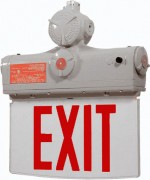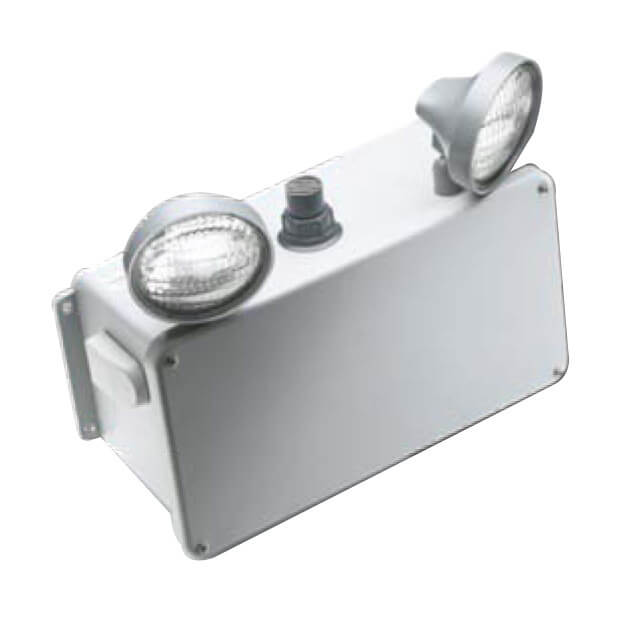THE DIFFERENCE BETWEEN HAZARDOUS LOCATION EXIT SIGNS
Placing illuminated exit signs in a hazardous environment can increase the hazard instead of decrease it. Any time you place electrical equipment in the vicinity of flammable materials you create a fire hazard. The solution for this problem is to design special equipment, like exit signs which are specially designed to insure that they are not going to create sparks.
VIEW ALL OUR HAZARDOUS LOCATION EXIT SIGNS
These exit signs are commonly referred to as hazardous area or explosion proof. However, it is important to note the difference between the two divisions of signs; as it both affects where we can install them and how much they cost.

Class 1 Div 2 Exit Sign Emergency Light Combos are designed for hazardous locations.
UNDERSTANDING THE CLASSIFICATION SYSTEM:
The classification system that we use for defining risks in hazardous environments comes from the National Electric Code (NEC). The NEC provides for three different classes of flammable risks, which are dependent upon the flammable materials which can be in the air. They also provide for two different divisions, which identify the probability of those flammable materials being in the air at any one time.
| CLASS I (gases and vapors) | Group A (acetylene) Group B (hydrogen) Group C (ethylene) Group D (propane) |
| CLASS II (dusts) | Group E (metal dust) Group F (coal dust) Group G (grain dust) |
| CLASS III (fibers) | No Subgroups |

Class 1 Div 1 Explosion Proof Edge Lit Exit Signs are extremely durable and attractive.
Based upon this system, the most hazardous area is one in which flammable gases or vapors (from flammable liquids) exist as a normal part of your operations. What makes it the most hazardous is that these gases and vapors can more easily penetrate the case of an electrical device. Once there, they are exposed to the possibility of an electrical spark, initiating a fire.
AREAS THAT FALL INTO THIS CATEGORY INCLUDE:
- Paint spray operations
- Dry-cleaning establishments
- Vehicle maintenance and fueling areas
- Petrochemical manufacturing plants
- Utility and gas plants
HAZARDOUS LOCATION EXIT SIGN APPLICATION
All of these areas require the installation of Class 1 Div 1 exit signs. Adjacent areas, defined as being separated by a solid partition wall, are considered Class 1 Div 2 areas, because the gases and vapors would not normally be in those areas, but only as a leak.
Most operations are designed so that storage and transportation of flammable materials is restricted to the areas which are immediately adjacent to the work areas. These areas, which are graded as Div 2 areas, do not need exit signs that are designed to as tight a criterion as those used in Div 1 areas.
MAKING IT SIMPLE
Here’s the simple way to understand the difference between Div 1 and Div 2. Say you have an electrical device that has gasoline poured on it. If it is a Div 2 device, you’ve got enough time to turn off the device, before the gas catches fire. If it is a Div 1 device, you can leave the gas there and leave the device running, without risk of fire.
Essentially, the difference between how Div 1 and Div 2 exit signs are designed is in how much attention is paid to sealing the sign from the entrance of gases and vapors. Since the Div 1 atmosphere is assumed to be constantly full of flammable gases and vapors, the sign must be very well sealed against the entry of those gases and vapors. However, in the case of Div 2 signs, the gases and vapors aren’t constantly there, trying to enter into the sign; therefore, sealing doesn’t have to be as tight, as long as it can hold off the entry of gases and vapors for enough time for them to dissipate.

